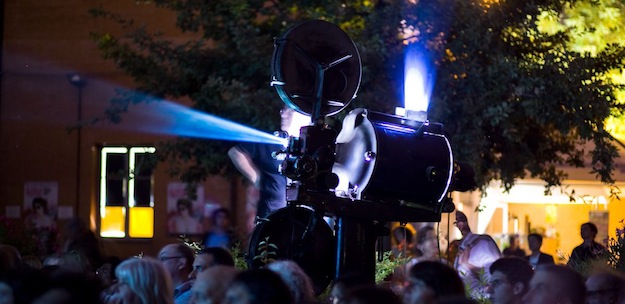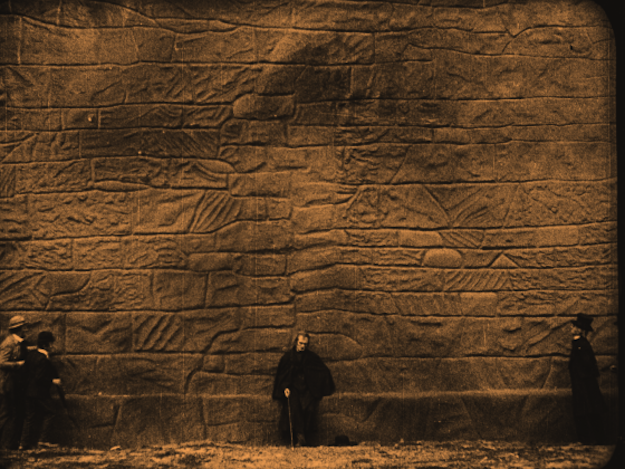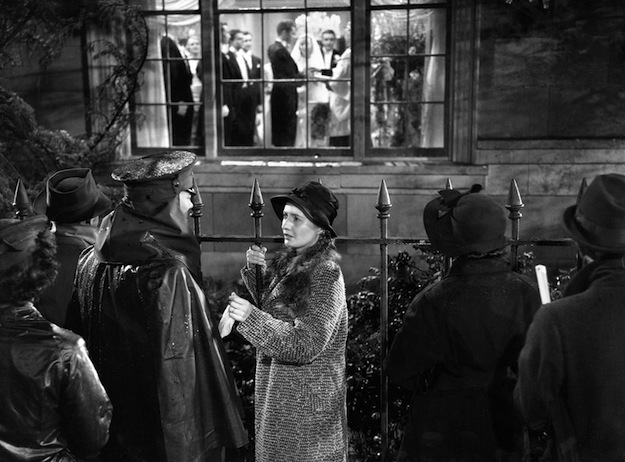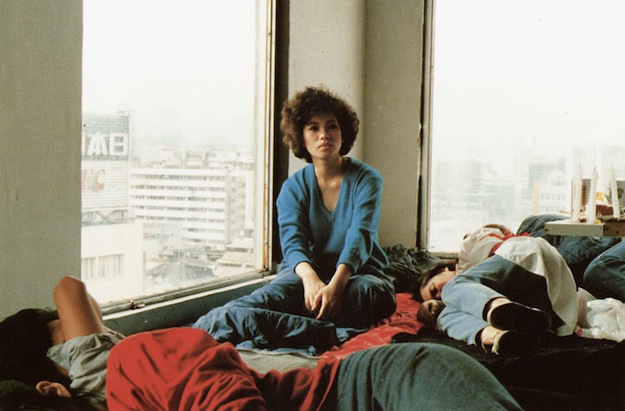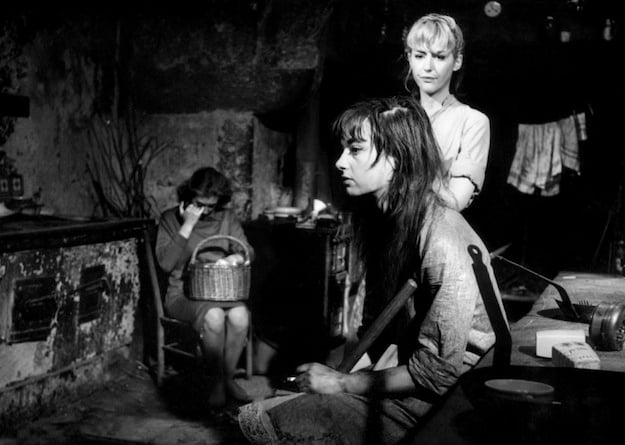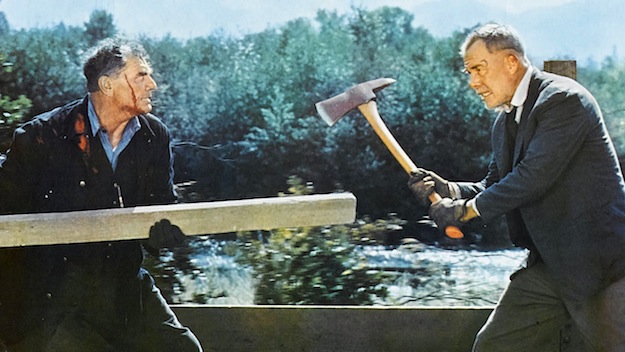Remembrance–A Small Movie about Oulu in the 1950s The Pathé shorts, which included Cambrioleurs modernes, screened in the cobblestone courtyard of the Cineteca Bologna, the Piazzetta Pasolini. There, the blue smoke emanating from the carbon arc projector drew as much attention from the crowd as the brilliantly hand-tinted costumes of L’Obsession de l’or (1906). A few select features every evening were showcased on the giant outdoor screen in the Piazza Maggiore, a wide, portico-flanked square in the heart of the old city. Whenever possible, films were screened in their original 35-milimeter splendor, though the frailty of some prints underscored how much of film history is in such advanced states of decay, not just archival oddities but irrefutable classics.
La Pointe Courte It’s difficult to imagine, for instance, that Agnès Varda’s La Pointe Courte (55), screened in DCP, hadn’t been restored until this year, or that there no longer exist negatives for the 35mm print of The Lodger (26), described by the director himself as “the first true ‘Hitchcock’ movie.” Even the more recent Bonjour Mr. Lewis (82), Robert Benayoun’s six-hour video exegesis on the comedy of Jerry Lewis, almost never screens, because of legal entanglements. At the very least Bologna is a reminder that much preservation, in an age of funding cuts to state archives and cinematheques, is the result of difficult, diligent, and too often unsung work. Though there was some grumbling that the festival, now in its 27th year, had grown too big—that the cinephiles’ secret was out—Il Cinema Ritrovato provided a rare opportunity to contemplate, in the warm glow of the carbon arc or in crisp DCP, the medium’s mutliple pasts, in an international film culture too often fixated on new releases.
Olympia 52 Many of Bologna’s offerings were presented for their relative obscurity, including Chris Marker’s debut feature, Olympia 52 (52), in a program of his “letters” travelogues. The film was screened in a cloudy digibeta transfer from the original 35mm; Marker had in fact opposed the restoration, calling the work not a film but a first attempt. Yet his chronicle of the 1952 Olympics in Helsinki offers more than mere historical interest to those seeking the early traces of a talent whose career spanned 60 years. Olympia 52 features Marker’s characteristically lyrical commentary, both in what the narrator reports and in what the camera shows. During the first half of the film, his curiosity ranges from architecturally angled shots of people walking through a pavilion of flagpoles, to glimpses of faces reflected in shop windows and, in a “serious moment,” a seal lumbering toward his lunch. In a chaotic interruption, a German peace advocate disrupts the opening ceremony proceedings by running onto the field; Marker dwells on the scene, clearly delighting in its anarchic jouissance. Even in the film’s second half, a more conventional reportage of the racing events, Marker’s attention sometimes drifts to athletes at humbler moments, whether stretching and pacing, or lying injured at the side of the track. Olympia 52 is a far cry from the sturdy bodies and heroic camerawork of Leni Riefenstahl’s Olympia, and Marker slyly inserts a clip from the latter that depicts a swastika-emblazoned flag to match one at Helsinki bearing the Coca-Cola logo. In contrast to Riefenstahl’s choreographed movements through custom-built sets and trenches, Marker’s handheld camera feels fragile, sometimes trembling with the wind. We watch with him from deep within the stands, and though his attention is focused on the games below, he can’t help but sneak glimpses of a boy sipping a milk carton, or a girl leaning anxiously in her seat. Throughout his work Marker addresses the notion of utopia, both its promise and its impossibility, and in Olympia 52, he finds it among the people, on a few days when the shadow of war had all but receded, and as the narrator concludes, “peace really means something.”
Kochiyama Soshun A similar attention to detail could be found in Kochiyama Soshun (36), one of three surviving films by Sadao Yamanaka, who directed 20 in all before being conscripted into the Japanese military and dying before the age of 30. Yamanaka’s period drama, shown in a 35mm print from the National Museum of Modern Art in Tokyo, bears the realist sensibility of a modern Japan struggling through an economic depression. Made with the progressive theater troupe Zenshin-za, the film centers on the plight of a young woman and her ne’er-do-well brother, and offers a rich portrait of a community of merchants, petty thieves, gamblers, geishas, and one samurai who is very anxious about his sword. For all the drama that engulfs this small world, Yamanaka finds moments of graceful symbolism, such as a cutaway to a broken toothpick left by a con artist after he resolves to fight on someone else’s behalf, in the first altruistic gesture he has ever made.
Five Men from the Circus Mikio Naruse’s big-top drama Five Men from the Circus (35), another selection from the program of early Japanese sound films, also displays an evocative choice of detail and deft formal construction. In early shots of an airborne performer grazing the drooping sides of the tent, the trapeze looms ominously like a warning of the potentially high human cost of spectacle. When the circus workers go on strike, and hapless members of a brass band are brought in as replacements, the manager tells them: “Even if you fall, the audience will like it.” The dreaded fall inevitably occurs in the midst of a noisy brawl, registered by a woman’s superimposed face as she watches in mute horror, and instead of seeing the performer plummeting, we’re left only with a dangling, empty swing.
The Iron Mask Lavish, heart-stopping spectacle could be found in Allan Dwan’s recently restored The Iron Mask (29), a swashbuckling vehicle for Douglas Fairbanks in his last silent appearance. Aside from awkward spoken interludes, the lithe Fairbanks makes no missteps as D’Artagnan, a role he had already played twice before. Without much in the way of cinematic embellishment beyond incredibly lavish sets, he hops walls, woos the girl, fends off his pursuers, and swiftly scales a tree as if unbound by gravity. Spanning 1911 to 1961, Dwan’s impressive output numbered over 400 films—he was called “that cyclone of the coast” in fan magazines—and in Bologna his rarest works, the early silents, were on luminous display. A world away from Dwan’s snappy, economical B-picture Fifteen Maiden Lane (1936) for Fox, for example, the silents demonstrate an expansive and commanding sense of space, especially in the Westerns. In Man’s Calling (aka Almost a Friar, 1912), the landscape traversed by a young man (J. Warren Kerrigan) reflects his profound dilemma. Journeying to the right, in the direction of the church, takes him down the path chosen for him by his father, while moving left leads him to the home of his eventual wife (Pauline Bush, later Dwan’s first wife). The man moves, at different moments, in both directions, and while the title cards are hardly more expressive than the one marking the word “Restless,” Dwan conveys a range of emotional states through complex spatial choreography. Similarly The Thief’s Wife (1912) employs deep focus and chiaroscuro lighting effects to illustrate a woman’s anguished plight. Through the window of a shadowy cabin, we watch the flight of her fugitive husband; later, she sobs on a porch streaked with sunlight, attended by a cowboy whose doleful expression indicates that he has fallen deeply and helplessly in love with her. In The Mormon (1912) Dwan uses a telescope to conjure an image of love at first sight, as a young Mormon spies a pioneer woman from across a wide prairie and eventually turns against his marauding brothers to join her side. She too knows how to handle a pistol: though they don’t always fare well, women in Dwan films tend to fight back. Most of Dwan’s work from this period has been lost; Man’s Calling and The Thief’s Wife were culled from the Library of Congress, while The Mormon was a 2k scan of a 35mm nitrate print, the work of Bologna’s L’Immagine Ritrovata restoration lab.
Tigris The early years of Dwan’s career were also a vibrant period for other filmmakers internationally. In a program selected from 1913, this year’s centennial, the films ranged wildly in scope and scale, from one-reeler genre pictures to epic serial features. The period’s extraordinary craftsmanship was evident in Vincenzo Denizot’s Tigris (1913), a 35mm print pulled from the BFI National Archive. In a nod to Méliès, the film begins with a split-screen demonstration of the same actor (Edoardo Davesnes) removing the costumes for the three characters he plays. To complicate matters, but also to show off the film’s virtuosity, the characters frequently don disguises as beggars, valets, and each other, as the detective Roland (Alessandro Bernard) pursues Tigris (Davesnes), the ringleader of a band of masked jewel thieves. While the transformations can be confusing to follow, Tigris dazzles with its stunning effects, including Roland’s miraculous survival on railroad tracks as a train approaches—he pulls himself up by the engine buffers—or, when he is drugged by Tigris, some kaleidoscopic images of a woman dancing over his muddled head. The most magnificent scene, however, comes without the aid of special effects: when Roland chases Tigris into a tunnel, the screen goes to black, only to be brilliantly lit with the flashes of gunfire.
Ingeborg Holm The storytelling on display in the 1913 program was no less sophisticated. In Victor Sjöström’s Ingeborg Holm, as harsh a social critique as any committed to film, a young widow (Hilda Borgström) is systematically broken down by the institutions that fail to help her—the poorhouse, the foster homes where her children are sent, and finally the insane asylum in which she cradles a rag doll, unable to bear the piecemeal dispersal of her family. Sjöström lets the camera linger on Borgström’s large eyes, which transform from expressing youthful exuberance, captured in a photograph, to displaying a dull glaze formed by 15 years of sorrow and neglect. No matter how happy the family’s eventual reunion, the reappearance of that photograph, shockingly dissimilar from the wizened woman on view before us, lays bare the devastation of those intervening years. The film’s restoration journey, too, was almost as dramatic as that of its suffering heroine: the restored 35mm print was struck from nitrate negatives in 1969, then in 1986, after a lost censorship edit was found, new scenes were added in, along with intertitle cards provided by the Svenska Filminstitutet.
Our Friends the Police Amid the variety there was even a surprise that the programmers hadn’t anticipated: an unnamed fragment of an Éclair actuality film shot in Shanghai and attached to the reel of Our Friends the Police (1913). The milky print of horse-drawn carts, bas-reliefs studies, and “plants with human aspects” screened with improvised piano accompaniment, and offered a glimpse not only of Shanghai but the perspective of those holding the camera as well. Such moments, when the camera’s view onto the world offered insight into that of the filmmaker, were apparent in Jackie Raynal’s Deux Fois (68), a bold experimental feature shot only months after the events of May 1968, and presented in Bologna by the Cinémathèque de Toulouse. Raynal mesmerizes as the film’s central figure, greedily eats her breakfast, whispers inaudibly into a man’s ear, and purchases soap in a drugstore while speaking multiple languages. These scenes, which are sometimes repeated as if culled from different takes, illustrate Raynal’s acuity as an editor as she highlights the constructed nature of synch sound, camera movement, and other filmmaking technique. In the middle of such self-reflexive gestures, the film shifts, and the camera swings in a full circle around a broad Barcelona boulevard. Passing by the faces of curious pedestrians, it opens an otherwise hermetic film to the winds of a rapidly changing world.
July Rain Marlen Khutsiyev’s July Rain (66), which screened in a gorgeous 35mm CinemaScope print in Bologna’s Cinema Arlecchino, begins with a similar pan across pedestrians on a crowded Moscow street before trailing a blonde woman. She’s later identified as Lena (Evgenija Uralova), but here, stopping under a shop awning during a sudden downpour, hers is just one story out of many. Like her friends, she’s a woman haunted by the memory of past wars and uncertain about her future. In portraying this tenuous present—an “era of peaceful coexistence,” as one character ironically puts it— Khutsiyev’s sensibility is distinctly modern, even suggestive of New Wave filmmakers, especially as the troubled romance at the center of the film continually brushes up against the gritty reality of the contemporary Soviet city. At the end, the film again takes a documentary approach to record a group of young men outside the Bolshoi Theater, where veterans have gathered to commemorate the Red Army’s march to Berlin. The camera studies the boys’ faces as they listen, though their expressions are ultimately inscrutable. In these various encounters, experienced sometimes through Lena, and sometimes through the wandering of the camera, July Rain suggests the obscure though inevitable passage of time.










title: “Festivals Il Cinema Ritrovato” ShowToc: true date: “2024-05-10” author: “Lesley Ocasio”
Les Vampires One of the reliable highlights of Bologna’s Il Cinema Ritrovato festival is its slate of centennial programs. While the major American productions—The Birth of a Nation and The Cheat—were missing from the 1915 lineup, there was a new digital restoration of Louis Feuillade’s serial Les Vampires (1915-17), with episodes playing daily, and with heroine Irma Vep adorning the official tote bags. This year also marked the hundredth anniversary of Technicolor, and the festival’s many archival partners dug deep into their vaults to pull out gorgeous vintage prints, including The Thin Red Line (98), shown in a unique dye-transfer print at the 10,000-seat open-air Piazza Maggiore—which remained packed for the entire 170 minutes—and All That Heaven Allows in a 1956 international distribution print with French and Dutch subtitles. Sirk’s Hudson-Wyman melodrama was presented by Nicola Mazzanti of the Royal Belgian Film Archive, who concluded his remarks by proudly bellowing: “Technicolor is like God. It cannot be copied.” Even the most beloved of classics require restoration and care, and for lesser or unknown works, the situation is all the more dire. These are films lucky for having survived at all, whether in the form of archival deep-dive finds, rediscovered footage, or “lost” films unearthed from mislabeled canisters or recovered in a fortuitous donation. Il Cinema Ritrovato, which is connected to the Cineteca di Bologna and L’Immagine Ritrovata, a major film restoration laboratory, is a festival deeply appreciative of the entirety of film history, including and especially its most vulnerable fragments. There was one festival catalogue entry, written by programmer Mariann Lewinsky, that I found particularly emblematic of the festival’s ardent and eclectic cinephilia. This is how she describes “The Programme of the Unknown Film,” a selection of 1915 rarities: Four out of the five films are incomplete; none of them will ever make it into official film histories or become available on DVD. All of them possess some particular quality, something surprising or beautiful or enjoyably silly . . . When if not now, and where if not here, will these films ever be screened and find the audience they deserve? Gentle viewer, it’s now or never. Lewinsky organized numerous early cinema programs, including several screenings of the work of Albert Samama Chikly, a Tunisian-born filmmaker, photojournalist, and all-around adventurer whose life and work are only now entering their rightful place in film history. Scholar Aboubakar Sanogo, one of several to assemble the Chikly programs, noted the fin de siècle artist’s significance in asserting the richness of African filmmaking during a time that is generally under-served or ignored in favor of the revolutionary cinema of the independence era. Beyond filling an historical gap, Chikly was also an impressive metteur en scène, as daring and inventive as Dziga Vertov: among his other feats, he built a wooden submarine to film underwater, shot aerial footage of Paris and Tunis from a hot air balloon, and volunteered for the French Army Film and Photo Units to document scenes of battle and life among the soldiers during the First World War. Chikly also was an enterprising exhibitor, building one of Tunis’s first cinemas, not to mention introducing the X-ray and the bicycle to his home country. He shot fiction films as well, including collaborations with his daughter, screenwriter and actress Haydée Chikly, but it is his documentary work that truly astounds.
Tunny Fishing in Tunis Chikly’s eye for composition is apparent in his still photography, but as a cinematographer he was also especially deft at coordinating movement. In Tunny Fishing in Tunis (1905), shown in a program of his nonfiction films from 1896 to 1914, his camera is mounted on a bobbing platform, one of several used to trap tuna. Men stand with harpoons all around the swaying enclosure, balancing themselves against the choppy water, and heaving giant fish into their boats. The sourced dolly is used in other films as well, a feat made all the more impressive given the cumbersome weight of cameras at the time. In his coverage of WWI, he placed the camera among the cars of an artillery convoy, showing close-up rows of large shells as they’re carried through the Verdun countryside. This shot was cut among distant views of explosions from the battlefield in Terre Sacrée (compilation d’images de la guerre) (1917-1918; “Sacred Ground (Compilation of Images of War)”) lending a sense of imminent danger amid the otherwise undisturbed landscape. In L’Offensive de Verdun du 20 Août 1917 (1917; “The Verdun Offensive of August 20, 1917”), Chikly’s camera is still, but placed at a midpoint in the trenches so that approaching soldiers rise up through the frame, their expressions captured in close-up along the way. Through his lens, we see images of war we’ve never seen before, then or since. In Les Marocains devant Verdun, Mars 1918 (1918; “Moroccans in front of Verdun, March 1918”) Moroccan soldiers don fezzes atop their gas masks; in L’Offensive de Verdun a dead horse lies half buried in the rubble, and, in one of the festival’s truly breathtaking moments on screen, soldiers strip on a beach in wide shot, then run to frolic in the sea. The centennial program also featured a number of “diva” films, made at a time when films were just beginning to attract audiences for their star power. The diva showcase was particularly popular in the vibrant Italian silent cinema, and the outdoor screening of Assunta Spina (Gustavo Serena, 1915), featuring the charismatic Francesca Bertini, proved their enduring appeal, drawing a sold-out crowd. (Though I imagine many also came to see the spectacle of the carbon-arc projector—even the projectionist snapped a few shots of its billowing blue smoke—the rich tinting of the lightly worn original 35mm print, or the guitar and mandolin duo accompanying the film with traditional Neapolitan music.) Compared to the high theatrics and tempestuousness of a contemporary diva film like Pastrone’s The Fire (1915), the story of Assunta Spina is relatively low-key. Assunta, a laundress, must choose between her wrongfully imprisoned husband and the man who offers to steal her away. Bertini shines, having previously performed the role onstage; she accepted to do a film adaptation on the condition that she also direct it (though she goes uncredited). The real star, however, is the Naples setting, its shoreline making its way into more scenes than seemed necessary, and its waters making for the film’s most striking image, that of two silhouetted lovers floating away on a small boat. Another diva film set in Naples, The Dumb Girl of Portici (1915-16), directed by Lois Weber and Phillips Smalley from Universal’s Bluebirds Photoplay division (though the film was a Universal production), features Anna Pavlova as the fisherwoman Fanella who gets caught up in the 17th-century peasant revolt against a Spanish fruit tax. Pavlova is a broadly physical actor—her grins and grimaces don’t do much for her heroine’s tragic story—but as the free-spirited Fanella is especially given to dancing, her frantic twirling conveys something of the film’s historical turmoil. What’s unique are the two dreamlike dance sequences that bookend the film. In the first, Pavlova dances in white against a black background, lifted by a concealed partner, also in black, to create the effect of her floating. In the second, she pirouettes and rises among clouds that are superimposed over her, as if liberating her from the tumult below. Bologna celebrated the 30-year career of Leo McCarey, for many years during Hollywood’s golden age the most sought-after director of comedies, with a program of his classics and rare shorts. As in Duck Soup (33), chaos tends to rule the day in McCarey’s films. Time and again, his characters get caught up in deceptions they’re forced to maintain, and in situations they’re decreasingly able to control. With the very funny and efficient short Sittin’ Pretty (24), a man impersonates a police officer to catch a car thief, but then gets called into a stakeout. Hijinks ensue: he accidentally volunteers to enter the murderer’s hideout, and in a gag made famous by Duck Soup, foils his enemy by mimicking his actions in a mirror. Improbably, he captures the murderer and wins the girl, but misses out on the reward. Even when ostensibly happy, McCarey’s endings are often only bittersweet. In Mighty Like a Moose (26), a husband and wife, unbeknownst to each other, each get plastic surgery, then seduce each other as strangers. The misrecognitions make excellent fodder for humor—at one point Charley Chase plays both the cuckolded husband and the new suitor as they chase each other through a hallway—but it’s impossible to shake the pall of doubt they cast.
The Return of Vasili Bortnikov Bologna’s grab bag made for some unexpected delights, including an agricultural theme running through a number of Soviet “early thaw” films of the mid-Fifties. In The Return of Vasili Bortnikov (53), Vsevolod Pudovkin’s final film, the business of collective farming is as important as the love triangle that, similar to Assunta Spina, develops between the soldier Bortnikov, presumed dead after the war, his abandoned wife Natalya, and the comrade who has filled his domestic shoes. In between moments of genuine pathos—as when Natalya admits to Bortnikov that she is confused about which man she loves, moves out, then gradually comes back to her husband—the kolkhoz workers fix tractors, plow fields, and install new machinery for milking and refrigeration. In one extended and genuinely moving sequence, the farmers sing a rousing song about tedding hay, and the music pauses when Bortnikov receives a letter and learns about his father’s death. For a moment, he sits against a flaxen wall and wipes away tears, then stands to rejoin the cheery crowd. The film was released only two and a half weeks after Stalin’s death, but the scene, and the film as a whole, suggests something of the change that was just beginning to happen in Soviet life. As the programmers Peter Bagrov and Olaf Möller put it in their introduction, there was “something different” in the air, a presentiment of the innovative stylistics of the next generation of Soviet filmmakers, here only barely suggested in the films’ attention to ordinary life and its slightest ambiguities. Another film from 1953, Magdana’s Donkey, made by Georgian filmmakers Tengiz Abuladze and Rezo Čcheidze, shows how regional filmmakers enjoyed some degree of independence from the prevailingly sunny Soviet Realism style of the national studio. In stark black-and-white compositions of the rocky plains, and with observational detail reminiscent of Italian neorealism, it adapts a children’s story about a donkey. The beast (a decade before Bresson’s Au Hasard Balthazar, also showing in a newly restored print) is left half-dead on the road by a cruel merchant, rescued by a group of peasant children, nursed back to health and usefulness, then cruelly reclaimed by the merchant in a tsarist court. The village gathers and mourns, which from a Soviet perspective makes it a happy, if qualified, ending. An earlier film, Amassi Martirosyan’s Kurdy-Ezidy (33), which was screened as part of a series on Armenian cinema, also reflected the Soviet agenda as it played out in the farther reaches of the nation. Despite its overtly propagandistic story about ethnic Yazidi Kurdish villagers overcoming exploitation by local sheiks through a Soviet literacy program, the film preserves their customs in rich documentary detail, from the prayers done at dawn and sunset to the weave of scarves used in celebratory dances. Attending a festival like Bologna shows that films are bridges to each other. The connections that may emerge in the course of a festival reveal continuities, whether intentional or not, sometimes within a single work. In Sohrab Shahid Saless’s A Simple Event (73), a landmark of the Iranian New Wave, it is possible to spot, or at least imagine, numerous influences in its aptly described simple, though no less devastating, story about the death of a boy’s mother. There are strains of neorealism in its delicate attention to the rhythms and repetitions of the family’s impoverished existence, and the spirit of Antoine Doinel in the young boy who does his best to win his parents’ affection. Shahid Saless studied cinema in Austria and Paris in the sixties, and he undoubtedly picked up on many European new wave currents before returning to Iran to make documentary films for the Ministry of Culture. Yet A Simple Event is also a stunning achievement on its own terms: a measured treatment of moments both large and small, and characters that express little outright, but whose implied anguish fills the screen. The influence of Shahid Saless on others can also be seen in the work of his Iranian New Wave peers. Abbas Kiarostami expressed particular admiration for A Simple Event, and he similarly adopted a child’s perspective as a way of describing social problems for Where Is the Friend’s Home? 14 years later.
The Memory of Justice Marcel Ophüls deals with the issue of legacy in ways both personal and political in The Memory of Justice (75), a sprawling four-and-a-half-hour documentary about the Nuremberg Trials, shown in a restored digital version. The film is engrossing, unpredictable and even at times punchy. For his interviews, Ophüls aimed both high and low, balancing footage of several high-profile Nazis that had been on trial, various lawyers, and concentration camp inmates who testified, with man-on-the-street questions as to the whereabouts of the convicted Nazi doctor Herta Oberhauer, and a discussion about the Holocaust among the fleshy patrons of a German sauna. At its best, the film produces a compelling sense of history, establishing a provocative link between WWII and the then-contemporary Vietnam War, two major events not usually conceived alongside each other, despite their historical proximity. The second part stresses this point, which is crystallized in one mind-boggling scene where Telford Taylor, the Chief Council for the US prosecution team at Nuremberg, stands next to Joan Baez in Hanoi, responding to a reporter’s questions about the bombing of a hospital. Through editing, Ophüls stages a number of memorable confrontations: between Taylor and Daniel Ellsberg, between the circumspect parents of a deceased Vietnam deserter and a stridently patriotic widow, between a German mother and her radicalized daughter, the Nazi hunter Beate Klarsfeld. Most powerful is the pairing of archival footage from the Nuremberg Trials with the account of Marie-Claude Vaillant-Couturier, a French resistance fighter interned at Auschwitz, who, after testifying, stared down Karl Dönitz, Albert Speer, and Hermann Göring as she walked past them. Despite the graininess of the black-and-white footage, the defiance of the then-young woman is electrifying. Ambition unfortunately gets the better of Ophüls—there’s simply too much to tell, and the film’s focus loses coherence when it veers into the history of Native American extermination or the Algerian War. Some footage seems included only because Ophüls couldn’t resist a great story, as when we hear the admittedly amazing account by a French deserter about a six-day journey across the desert with an escaped prisoner. As a record of its own time, The Memory of Justice depicts a moment when all historical events seemed alive and connected, and Ophüls himself is right there, bespeckled and balding, eager to document it all. He was, unfortunately, unable to make it to Bologna for the screening. During the film’s introduction, programmer Cecilia Cenciarelli explained that she received a fax from him describing how he had gotten in his car with his dog and begun the drive to Italy. Then another fax came in: it was “too bloody hot” and he had turned around. “Maybe next year,” he said.
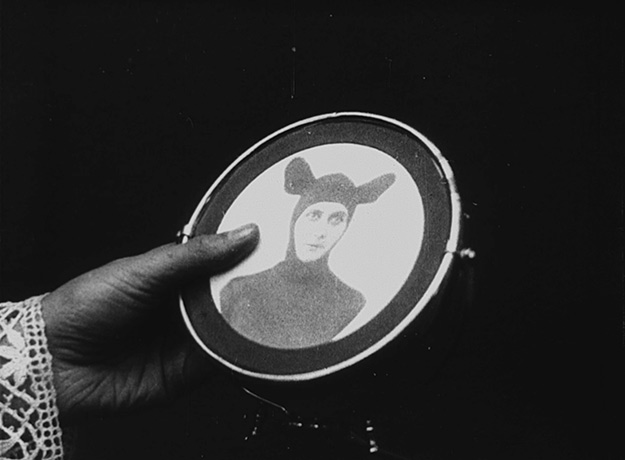
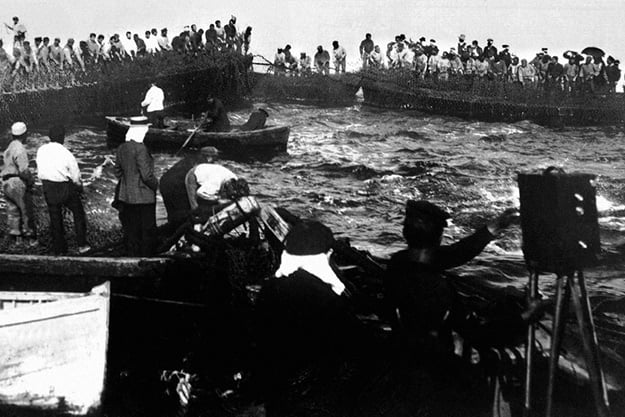
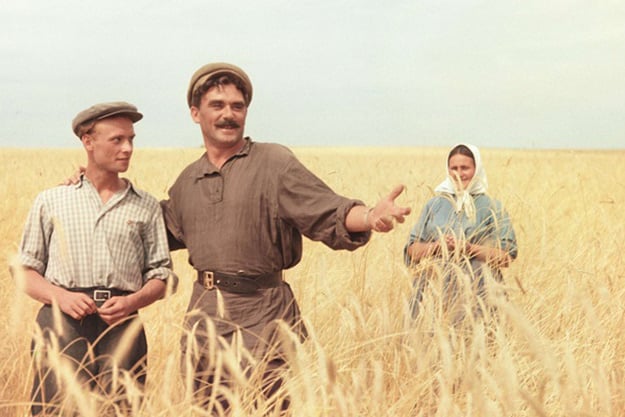
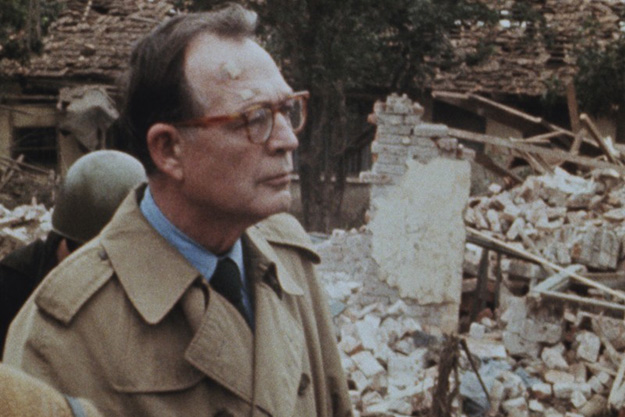
title: “Festivals Il Cinema Ritrovato” ShowToc: true date: “2024-05-27” author: “Jackie Demar”
Monument Film During a panel on the evolving dynamic between digital and chemical processes in film restoration and distribution at this year’s Il Cinema Ritrovato, Grover Crisp of Sony Pictures noted that for the worldwide release of The Amazing Spider-Man 2 the studio made only 700 film prints (with 500 going to Brazil), while just a handful of years ago, thousands of prints were made for a typical summer blockbuster. The very next evening, in the Piazetta Pasolini of the Cineteca di Bologna, the experimental film legend Peter Kubelka electrified the audience with the filmiest of film programs: his Monument Film (12), composed of his flicker films Arnulf Rainer (58-60) and Antiphon (12) projected consecutively, side by side, and on top of one another in a grand celebration of the formal qualities of film. Kubelka’s introduction took on an elegiac tone as he bemoaned the rise of digital, as an artist committed to working on film but unable to halt its demise. Such are the contradictions and compromises that the field of preservation and the festival find themselves navigating. Counting shorts, more than 200 movies screen in the lineup each year, and it is a given that more and more are shown digitally, mostly in the form of new digital restorations but also for lack of film prints. A robust selection of titles are still screened in 35mm, with some showing extreme signs of wear.
Night of the Storyteller Now in its 28th year, Il Cinema Ritrovato (“rediscovered cinema”) brings together archivists, critics, curators, filmmakers, and eager cinephiles for perhaps the most enjoyable and egalitarian week of archival and repertory cinema to be found anywhere in the world. A weekly pass to the fest is 80 Euros, a relative bargain compared to other large international festivals, and it grants the general public virtually the same level of access to its many offerings as anyone else in attendance. “Rediscovery” can have a number of meanings at Il Cinema Ritrovato. Perhaps the most literal example this year was Robert Flaherty’s Night of the Storyteller (35), the first film shot in Irish Gaelic, restored by the Harvard Film Archive from a 35mm nitrate print found on a shelf there last year. Another example is Why Be Good? (29), a Warner Bros.–Vitaphone feature starring the great silent star Colleen Moore that was thought to be lost for decades but was brought back to light by a pair of persistent historians who knew of a print in an Italian archive. Conversely, Fred Zinnemann’s Oklahoma! (55) could hardly be considered a lost film, but it proved to be new to many eyes, and its restoration was only possible with new digital technology. As 20th Century Fox’s Schawn Belston explained, special processes were developed to address the color fade of the 65mm interpositive and the fact that the Todd-AO version of the film was shot at 30 frames per second.
Maciste all’inferno In any case, there are simply too many films in the festival to see everything, or even representative samples from each program. It was never lost on me that picking one film over another could mean missing my final opportunity to see something ever again (in a theatrical setting, at least). There were spotlights on Indian films from the Fifties, Germaine Dulac, Polish New Wave Cinemascope films, and films from the Ottoman Empire from 1896 to 1914, and I didn’t see any of them. One strong program was the spotlight on Italian director Riccardo Freda. Averse to both comedy and postwar neorealism, Freda directed popular films across genres including melodrama, horror, period piece, and adventure. My favorites included Theodora, Slave Empress (53), a sword-and-sandal epic about a slave girl who ends up marrying the emperor; the historical melodrama Beatrice Cenci (56); and Maciste all’inferno (62), an entry that finds the recurring Hercules-like hero happening upon a 19th-century-style witch-burning frenzy (why not?). Another strand of interest was “Cinema at War Against Hitler,” an international selection of films produced during Nazi rule as well as a pair of postwar films. James Hogan’s The Strange Death of Adolf Hitler (43) depicts a Viennese man with a talent for impersonations who is forced to become a double for Hitler. The man’s death is faked and he’s branded a traitor, leading his wife to seek revenge for what has become of her family. John Farrow’s The Hitler Gang (44) might best be described as a Classics Illustrated–style life of Hitler (played by Robert Watson), featuring all the major players and incidents from the Führer’s rise to power including the eager-to-please, ever-frustrated Rudolf Hess (Victor Varconi). The extremely rare Hitler’s Reign of Terror (34) is more intriguing for its backstory than as a finished film, but makes for a fascinating document nonetheless. In 1933, Cornelius Vanderbilt Jr. traveled throughout Europe with two cameraman to interview heads of state including the newly elected Chancellor of Germany. The film is comprised of interviews, newsreel footage, and reenactments, one of which depicts Vanderbilt pressing Hitler with the question “And what about the Jews?” When the German ambassador at the time protested its release, the film was pulled from distribution, but it was re-released in 1939 with some I-told-you-so additions by Vanderbilt.
Life Begins Tomorrow I saw only one film in the festival’s retrospective of German director Werner Hochbaum, Life Begins Tomorrow (33), which emerged as the consensus favorite among his films. The story follows the release of a man from prison, the series of events that prevents his wife from picking him up, and the mistrust that follows. It echoes moments of silent-era Fritz Lang as well as Walter Ruttmann’s Berlin: Symphony of a City and Paul Fejos’s Lonesome, and anticipates much of the cinema of Jean Grémillon. Another often terrific series spotlighted individual episodes from the many Italian omnibus films made between 1952 and 1969. Three stood out for me. Directed by and starring Nino Manfredi, L’avventura di un soldato (62, from L’amore difficile) tracks the currents of sexual desire and repression between a soldier and a woman aboard a train. Luigi Filippo D’Amico’s comedy Guglielmo il dentone (65, from I complessi) stars the incomparable Alberto Sordi as a man participating in a contest to become a television news reader. He’s supremely qualified in every way—poise, eloquence, intelligence—but possesses a set of protruding teeth that are impossible to ignore. In Eduardo De Filippo’s fable-like Cova delle uova (52, from Marito e moglie), Tina Pica plays a peasant woman who obsesses over her hens at the expense of her sickly husband (De Filippo), whom she suspects of malingering. When she discovers that his fever is the perfect temperature for hatching eggs, she becomes much more interested in keeping him in his bed. In honor of the 100th anniversary of Charlie Chaplin’s Tramp, the Cineteca di Bologna hosted a Chaplin conference prior to the festival. There was also a suite of restored Essanay films and an exhibition of art by Léo Kouper, perhaps the artist most associated with illustrating the Tramp in promotional materials.
The Most Wonderful Evening of My Life No trip to Il Cinema Ritrovato is complete without watching at least one of the nightly films under the stars in the Piazzetta Maggiore, surrounded by thousands of other moviegoers. This year I watched Ettore Scola introduce his The Most Wonderful Evening of My Life (72), starring Alberto Sordi as a somewhat shady fabric salesman who gets stranded at a Swiss lodge inhabited by a group of professionals and aristocrats. He quickly finds himself at the center of an elaborately staged parlor game with echoes of The Wicker Man or The Most Dangerous Game. Finally, one of the great pleasures of the festival is revisiting a film one may have seen before, even multiple times, in a new restoration and with an audience that is often composed of younger viewers seeing the film for the first time. It was fun to see Vittorio De Sica’s Marriage Italian Style (64) again, and the screening was made even more enjoyable by the extra delight that the mostly Italian viewers seemed to be experiencing seeing their national screen icons Sophia Loren and Marcello Mastroianni together in a great film on a big screen as part of an audience. I’m left to wonder what the quite similar audience in the same theater thought about Rock Hudson’s café brawl set to “The Yellow Rose of Texas” at the end of Giant (56) earlier in the festival. Molto americano.





title: “Festivals Il Cinema Ritrovato” ShowToc: true date: “2024-04-22” author: “April Powell”
“It has gotten so big in recent years”: I heard some variation of this sentiment multiple times each day at this year’s edition of Il Cinema Ritrovato. This being only the second year I’ve traveled to Bologna, it was difficult for me to gauge the veracity of such a notion, which seemed—especially when put forward by any number of ICR vets—to contain a not-so-subtle subtext of “and boy, what a pity.” But regardless of its expanded lineup or the increased number of attendees, Il Cinema Ritrovato remains a rare beast indeed: a one-week, primarily repertory film festival, mind-bogglingly dense with new restorations, legendary prints, discoveries and rediscoveries, canonical works presented under optimal screening conditions, and an abundance of curios dating from the birth of the medium. Seemingly every international film archive was represented in one form or another (the festival overlapped with the annual congress of the International Federation of Film Archives, also held in Bologna this year). The attendees ranged from intrepid programmers in search of curatorial inspiration and advance glimpses at new restorations, adventurous critics and scholars on the historiographic prowl, relatively few industry types who have made the history of cinema their business, and even some game civilians. Suffice it to say, one feels the cine-love pretty quickly, and the festival’s facade of being a utopian film-nerd meet-up seems more or less truthful. The first night featured an outdoor screening of the Cineteca di Bologna’s recent digital restoration of Chaplin’s Modern Times (1936) on the Piazza Maggiore, the city’s largest public square. If you didn’t get there an hour or so ahead of time, you were condemned to stand nearly a football-field away from the massive screen and enjoy the presentation upright: the festival’s Piazza screenings, free and open to the non-badged public, are grand-scale happenings so huge and egalitarian that you quickly get over your disappointment that fatigue (whether due to jet lag, too many movies, or a day spent staving off punishing temperatures while hustling from one semi-air-conditioned cinema to another) has ensured that you will likely watch 20-some minutes before calling it a night.
Destiny Similar borderline-frustrations emerged over the bevy of silent films shown in the festival’s Sala Mastroianni, the site for many a can’t-miss screening despite being one of ICR’s smallest venues. A screening of the Cohen Film Collection’s new restoration of Buster Keaton’s Seven Chances (1925) was filled well past the theater’s capacity, but as soon as the film’s proto-Technicolor opening graced the screen, the venue’s sardine-can atmosphere rapidly came to seem neither here nor there. Keaton is perhaps the festival’s biggest perennial draw and a frequent star of its promotional materials; Seven Chances, although seldom cited as a Buster masterpiece on the level of Sherlock Jr. or The General, remains a work of relentless hilarity and visual invention of another order, highlighted by a majestic chase scene in which our hero must escape the violent indignation of a small army of would-be brides. (Hell hath no fury like a woman who responded to an ad in the newspaper…) That this film was immediately followed in the same venue that afternoon by a screening of the Murnau Foundation’s beautiful recent restoration of Fritz Lang’s Destiny (1921) speaks to the can’t-go-wrong vibe of the festival’s slate: stand in the back for a packed-to-the-gills projection of a Keaton, grab a seat as the theater thins out between screenings, and gear up for a glorious, immersive presentation of Lang’s time-traveling psycho-goth epic, with plenty of time to spare for an aperitif before a typically languorous Bolognese dinner and a slew of options for evening screenings to attend. Murnau Foundation representative Ernst Szebedits noted in his introduction that the first section of Tarantino’s The Hateful Eight is a rather obvious homage to the beginning of Destiny, a perfectly fitting observation to make at a festival that so completely and pleasurably collapses the past into the present.
Stella Dallas The festival’s growing popularity has trickled down to affect its other plein air screenings, held on the comparatively small Piazzetta Pier Paolo Pasolini. This year ICR introduced a RSVP system to cap the seated audience at around 150, with the less on-it attendees having to make do with sitting on the ground, leaning against a tree, or rooting around for a chair to borrow from the festival’s outdoor café. Stakes were high: the two screenings I caught in this setting were ones for the ages, carbon arc lamp projections (using an antique projector that festival programmer Mariann Lewinsky dubbed “the Grandmother”) of Henry King’s transcendent weepy Stella Dallas (1925) and Jean Epstein’s landmark dockside melodrama Cœur fidèle (1923), the latter shown in the context of a retrospective for Epstein’s sister and frequent collaborator Marie, organized by the Cinémathèque Française and screening from an immaculately preserved 35mm print from its collection. The carbon arc lamp yields a shimmering, inky, rich black-and-white that assumes an inescapably trippy aspect as polychromatic plumes of smoke escape from the apparatus each time the projectionists swap out a burnt-up carbon rod. Incidental psychedelia notwithstanding, Stella Dallas proved a major revelation for many of us, an undeniable emotional tour de force helmed by one of the studio system’s most underrated craftsman. King may have been the directorial regent at Fox for a time, but his reputation has long been negligible among auteurist cults; Stella Dallas’s heartrending tale of maternal love, embarrassing parents, and class-based fatalism, deftly pitched and already bearing several of King’s later-career signatures (ahead-of-his-time location shooting and a refreshingly meandering way with narrative), was evidence enough that a widespread reappraisal of his oeuvre is overdue. An altogether different kind of psychedelic trip was the Academy Film Archive’s “Technicolor Reference Collection Show,” a stunning assortment of Technicolor reference elements presented by a squad of the Academy’s archivists—nine films represented in total, mostly by way of half- and partial-reels with heads and tails left on—before a totally packed house in the Cinema Arlecchino, the festival’s most civilized venue (serviceable sightlines, perceptible air-conditioning, etc.). Comprised of fragments of Ford’s The Quiet Man, Dwan’s Silver Lode, Hawks’s Rio Bravo, King Vidor’s Solomon and Sheba, Hitchcock’s To Catch a Thief, and, of course, multiple Douglas Sirk films, to name a handful, this program of semi-pristine material that was never intended to be screened theatrically (reference prints were struck during color-grading, prior to the production of exhibition prints in ye olde Technicolor workflow) was unlike anything most of us had seen before. Never had I made particular note of the use of color in The Quiet Man—represented by its horse race scene, in which Maureen O’Hara’s shiny red dress cuts a garish figure across the puke-like palette of the Irish landscape—nor had I picked up on just how funny the scene in To Catch a Thief where Cary Grant’s cat burglar ham drops a chip into a fellow gambler’s cleavage is. The program was firstly about pure engagement with those sensuous surface qualities that only Technicolor can afford (even where the final color schemes for several of the films differed considerably from what one finds in the reference elements), but oddly, a kind of exquisite corpse “film” emerged across the various fragments, tossing new light onto previously obscured aspects even in movies as worn-in and all-too-familiar as All That Heaven Allows. As Academy Film Archive director Michael Pogorzelski put it in his introduction, only at Il Cinema Ritrovato could such a program fill every seat in quite a large theater.
Taipei Story For those looking to latch onto a few of the festival’s constituent series/retrospectives and ride them out, the options were doubtlessly appealing: the aforementioned tribute to Marie Epstein; an “alternate” history of Argentinean cinema, curated by the filmmaker Edgardo Cozarinsky and critic Fernando Martín Peña; a version of the Museum of Modern Art’s series of films produced at Universal under Carl Laemmle Jr., programmed by MoMA’s Dave Kehr; the second part of last year’s enticing history of color in Japanese cinema; a retrospective for little-known-in-the-U.S. Italian screenwriter/producer/director Mario Soldati; retros for Marlon Brando and Jacques Becker; and many others I scarcely had time to try out. Several of these have already appeared in one form or another on the New York repertory circuit, but there’s something to be said for delving into such a strange (and remarkably efficient) film as James Whale’s The Kiss Before the Mirror (1933) alongside an international crowd, nested between viewings of Becker’s superb provincial whodunit Goupi Mains Rouges (1943) and a splendid O.G. Technicolor print of Hitchcock’s Marnie (1964). Context goes a long way toward determining what one gets out of a film, and the embarrassment of riches represented by ICR’s slate not only demanded that viewers situate these films in a century-plus, globe-spanning historical continuum, but also heightened the pleasure of taking a chance on something one has never heard of. In short, even when the films weren’t great, the exciting sense of taking a casual stroll on cinematic history’s beaten paths and neglected trails alike never dissipated. Two discoveries, one well-known and the other not so much: The Film Foundation presented its new digital restoration of Edward Yang’s Taipei Story (1985), a masterpiece that historically hasn’t been easy to see in the States. A delicate work of low-key modernism, imbued with fragile melancholia and an astonishing turn by none other than Hou Hsiao-hsien in the male lead, the restoration of Taipei Story will likely go a long way toward reaffirming its rightful place as one of the key films produced in southeast Asia near the end of the 20th century, on a par with Yang’s towering (both in terms of stature and duration) A Brighter Summer Day (1991). Nico Papatakis’s Les Abysses (1963), digitally restored by Gaumont, was a thoroughly startling experience; based on the infamous case of the Papin sisters that also inspired Jean Genet’s The Maids and Claude Chabrol’s La Cérémonie (1995), Les Abysses puts viewers on notice from the get-go with a pre-credit montage that frenetically summarizes the entire plot, albeit in head-spinning disorder.
Les Abysses Papatakis had sought the permission of his friend Genet to adapt The Maids, but when Genet declined, Papatakis elected to spin his own tale of murderous housekeeping sisters cracking up in the countryside. Good thing, too: Papatakis’s knotty narrative is a wholly distinctive, funkier animal, marked equally by rapturous flights of hysteria and play with class and gender that’s subtler than meets the eye. (Plus, it’s genuinely funnier than Chabrol’s eminently mean-spirited black-comic zenith.) If one could hang with the no-chill theatricality of the film’s performances and its highly flammable approach to staging chamber drama, Les Abysses was quite a blast. But perhaps the most pleasurable screening I caught all week was of Robert Aldrich’s Depression-set Emperor of the North Pole (1973, also known sans Pole), a delightfully arbitrary, rollicking freight train of an existentialist action-comedy, starring Ernest Borgnine and Lee Marvin at their “complicated tough guy” best and a baby-faced Keith Carradine sprawling in every which direction. Affectionately referred to by many fellow attendees as “Aldrich’s hobo film,” Emperor of the North Pole chronicles a mortal duel between Shack (Borgnine), a sadistic train conductor looking to maintain his unblemished record vis-à-vis freeloaders at any cost, and Marvin’s Emperor, the mumbling pound-for-pound champ of hitching a ride who reluctantly takes on Carradine’s arrogant rookie as his train-hopping protégé.
Emperor of the North Pole The action is dirty, nasty, and totally legible; the comedy, understated and set into motion by its players’ irresistible charms. One can almost overlook the film’s utterly ridiculous opening theme, “A Man and a Train,” whose lyrics exhaustively (and quite literally) catalog the many traits that distinguish men from trains. (A fellow programmer told me that legend has it Carradine originally penned “It Don’t Worry Me” from Robert Altman’s Nashville to serve as the theme for Emperor of the North Pole, but Aldrich passed.) Running from one balmy Bolognese cinema to another in search of celluloid kicks, it was easy to identify with Marvin and Carradine’s wily tramps—like any habitually curious cinephile, they’re always on the move, always sneaking onto another proverbial train bound for God-knows-where. Dan Sullivan is the assistant programmer at the Film Society of Lincoln Center.
